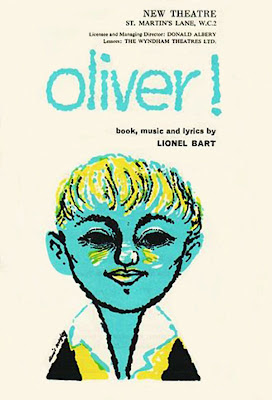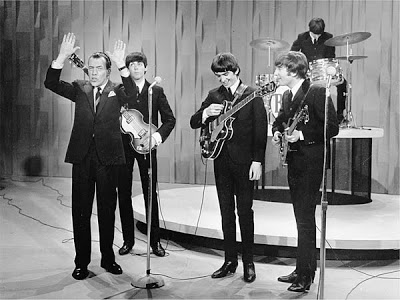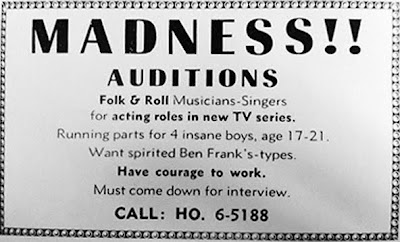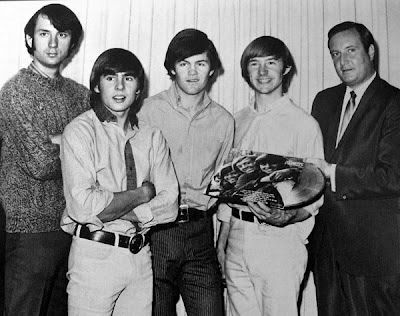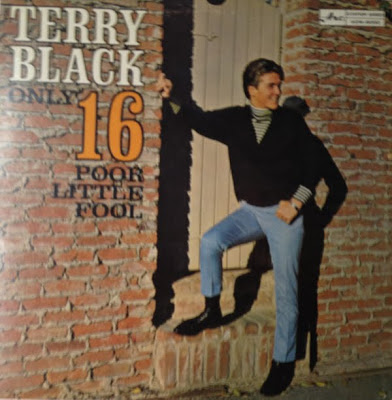I’m going to talk about Terry Black in a bit, but first some news. There is a kind of six-degrees-of-separation connection which I’ll explain later.
The pop music world lost another legend last week with the passing of Davy Jones of The Monkees. David Thomas Jones was born in Manchester England on 30 December 1945, just 40 clicks east of Liverpool where Paul McCartney had been born three and a half years earlier. At age 14, David got an early start as an actor playing Colin Lomax on the British soap opera Coronation Street. In that same year his mother died of emphysema. Davy decided to quit school to become an apprentice jockey. He began working with trainer Basil Foster, but that didn’t last long. David was soon recruited to join a theatre group in the West End of London to star as the Artful Dodger in the musical production of Oliver!
A week after his 17th birthday, that role took David from London to Broadway and earned him a nomination for a Tony Award. He and co-star Georgia Brown appeared on the Ed Sullivan show on 9 February 1964 to sing a couple of songs from the show.
As fate would have it, that turned out to be the same night The Beatles made their American television debut. Davy watched them perform from the side of the stage, saw the teenage girls screaming and crying, and decided he wanted a piece of that action! He got a contract with Columbia Screen Gems and got some more exposure on American television. In fact, a week or so ago I showed you some footage of Davy Jones appearing on The Farmer’s Daughter playing a rock and roll musician singing Gonna Buy Me A Dog. David began cutting records for Columbia’s Colpix label and managed a #93 Billboard chart hit with his second single, What Are We Going To Do, in 1965. He was well on his way to becoming a teen idol in places like Chicago where his record climbed to #30 on the WLS Silver Dollar Survey. This prompted the release of his first album, simply called David Jones, which was also issued on Pye Records in England.
Things were happening quickly for David. On 8 September 1965, he learned about this ad for auditions in Daily Variety, but never actually saw it. Ironically, another recording artist on Colpix who called himself Michael Blessing, real name Mike Nesmith, also heard about the auditions without actually seeing the ad. Peter Tork didn’t see it either. He learned about the auditions from his friend Steven Stills. Micky Dolenz heard about the auditions from his agent and didn’t actually see the ad either. You’re looking at an ad that changed the lives of these four young men, even though none of them ever saw it!
The audition was being conducted by producers Bob Rafelson and Bert Schneider who were crafting a show inspired by the Beatles movie A Hard Day’s Night featuring a fabricated Beatle-esque rock and roll group called The Monkees. Davy Jones was one of the 437 young men who showed up for those auditions, along with Steven Stills and John Sebastian. The producers originally wanted to sign John Sebastian’s Lovin’ Spooonful as The Monkees, but a previous recording contract made them unavailable. Instead, as everyone now knows, David “Davy” Jones, Micky Dolenz, Michael Nesmith, and Peter Tork were selected to play The Monkees on television.
Davy Jones passed away last Wednesday, 29 February 2012, at Martin Memorial South Hospital in Stuart, Florida. He’d been found sitting in his car that morning having trouble breathing and complaining of chest pains. He suffered a massive heart attack caused by atherosclerosis. Our hearts go out to his wife Jessica, and his four daughters (from previous marriages), Talia Elizabeth, Sarah Lee, Jessica Lillian, and Annabel Charlotte.
Everyone knows by now that The Monkees were allowed to sing on their early hit recordings, but did not write the songs or play instruments. Their songs were carefully crafted to become hits by Don Kirshner and written by his Brill Building superstars. These songs were recorded in Los Angeles, often using studio musicians who drummer Hal Blaine called The Wrecking Crew. These guys were mainly jazz musicians who were extremely versatile players. They were the “A Team” in Hollywood and used on hundreds of projects including television theme songs, film scores, jingles, and pop hits. In addition to The Monkees, other notable artists who used these guys included Bobby Vee, The Carpenters, The Beach Boys (on California Girls and Good Vibrations), The Byrds (on Mr Tambourine Man), Simon And Garfunkel, The Mamas And The Papas, The Partridge Family, John Denver, Nancy Sinatra, and even Bing Crosby and Nat King Cole. Producer Phil Spector used the Wrecking Crew to develop his Wall Of Sound production style. In addition to Hal Blaine, some of the other musicians who became members of The Wrecking Crew included Glen Campbell, Al Casey, Billy Strange, James Burton, Jerry Cole, Nino Tempo, Plas Johnson, Leon Russell, Mac Rebennack (Dr. John), Larry Knechtel, Earl Palmer, Julius Wechter, Jack Nitzsche, and many many more, including a very talented female bass player named Carol Kaye.
The Wrecking Crew was also called in by producers P F Sloan and Steve Barri to back a young Canadian singer named Terry Black.
Terry Black was born on 3 February 1949 in Vancouver, British Columbia, Canada. Terry was just 15 years old when he began singing on Buddy Clyde’s Dance Party show on CHAN TV in Vancouver. The fan mail received by the station prompted Bill Gilliland of Arc Records to sign him to a recording contract. Buddy Clyde helped connect Terry with the owners of Dunhill Records in Los Angeles. When he was just 15 years old he became a teen idol with his first hit single, Unless You Care, featuring Wrecking Crew members Glen Campbell on guitar, Hal Blaine on drums, and Leon Russell on organ. That single was released in the United States on the Tollie label near the end of 1964. Coincidentally, this is the same label that issued a couple of demo recordings by The Beatles in 1964, There’s A Place b/w Twist And Shout. Small world, isn’t it?
Here’s Unless You Care by Terry Black on Tollie 1074 from 1964:
Almost all of Terry Black’s several Canadian hits were written and produced by P F Sloan and Steve Barri, the guys who also worked with Jan And Dean, The Turtles, The Grass Roots, and many more 1960’s superstar recording artists. Today’s New Oldie is the flip side of one of Terry Black’s Canadian hits, a cover of Russ Hamilton’s 1957 hit, Rainbow. This song was written by P F Sloan and Steve Barri and, in fact, comes from a demo recording made by P F Sloan himself. Terry Black was not involved in any way, except getting credit for it on the single. Remind anyone of The Monkees?
Here’s There’s Something About You by Terry Black on Arc 1125 from 1965:
Here’s the flip side, Rainbow, which went to #22 on 1050 CHUM in Toronto in February 1966:
Terry Black won the Top Male Vocalist Of The Year award at the 1964 RPM Magazine Maple Music Awards, which later became known as the Juno Awards. Like Davy Jones, Terry Black got involved in acting. Following a job transfer, Terry’s father moved his family to Hollywood in January 1966. Shortly afterward, a movie script was made that was designed to feature Terry as the brother of Elvis Presley. His hopes of becoming the next Frankie Avalon were dashed when the movie didn’t pan out. Disgusted by the politics of the movie business and encouraged by his old boss Bill Gilliand, Terry decided to go back to Canada in 1968. He performed in clubs around Toronto, then joined the cast of the Toronto production of Hair! in 1969. Terry shared that stage with singer Laurel Ward and the two of them were married in 1970. They started performing and recording together as Black And Ward for Doug Riley’s band called Dr. Music. After 2000, Terry could be heard hosting an evening oldies show called The Sixties At Six on NL Radio in British Columbia. Terry Black passed away in Kamloops on 28 June 2009 after suffering for a year with multiple sclerosis. He was just 60 years old.
I’m in the process of adding the Canadian RPM singles chart information to my MusicMaster Oldies database, a process that has led me to discover several other “hit” records from the 1960’s. You can expect to start hearing those songs in the mix real soon!



